How to Create a Facebook Retargeting Campaign Easy Guide Cpc Strategy
Facebook advertising is an important way to connect with your audience on the world's largest social network. How large? 2.80 billion monthly active users large, to be precise.
Sure, that's an impressive number. But Facebook ads are all about getting your message in front of exactly the right segment of those people. The people who are most likely to actually want your products or services.
If you want to get the best results, it's important to understand the different Facebook ad types and targeting options before you dive in.
In this Facebook ads guide, we'll walk you through everything you need to know, from planning your first ad to developing advanced campaign strategies.
Bonus: Get the Facebook advertising cheat sheet for 2022. The free resource includes key audience insights, recommended ad types, and tips for success.
Types of Facebook ads
Image ads
These simple ads are a great way to get started with Facebook paid advertising. You can create one with just a few clicks by boosting an existing post with an image from your Facebook Page.
Image ads may be simple, but that doesn't mean they have to be boring.
For example, you might think domain names are a pretty ho-hum product. But that doesn't stop the Canadian Internet Registration Authority from creating fun Facebook photo ads.

Source: Canadian Internet Registration Authority on Facebook
Video ads
Video ads can run in the News Feed and Stories, or they can appear as in-stream ads in longer Facebook videos. Video ads can show your team or your product in action, like this quick demo video ad from Abeego.
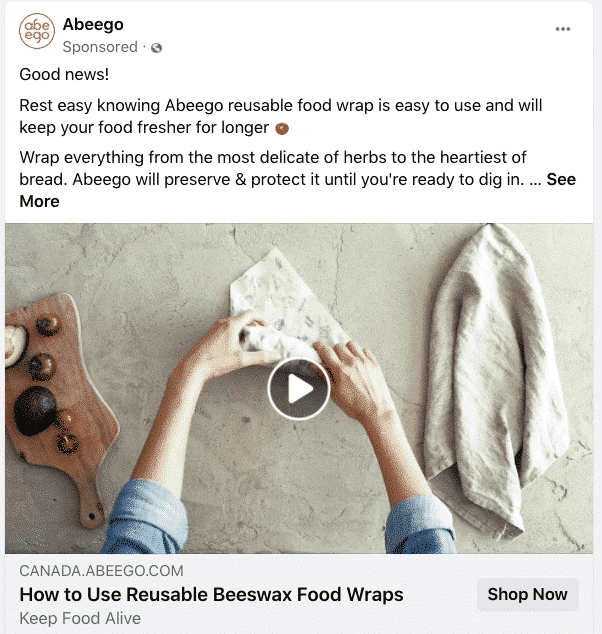
Source: Abeego on Facebook
Just like image ads, video ads can also take a more creative approach, like this one from Tru Earth:
Your video ads don't need to use filmed video footage. You can also create GIF-like graphics or other animations to capture attention or explain your offer, like in this video ad from IKEA.
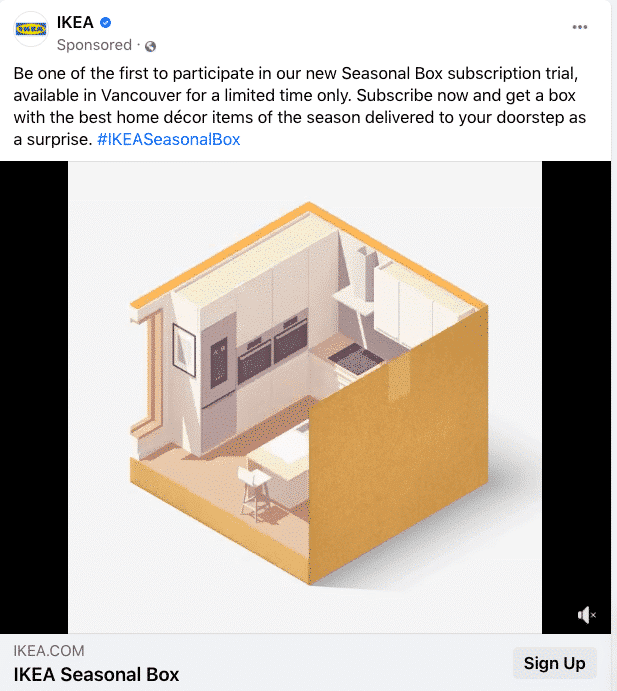
Source: IKEA Canada on Facebook
Poll ads
This mobile-only Facebook ad format incorporates an interactive component by adding a two-option poll to an image or video ad. You can add a separate link for each poll choice.
Both you and those who answer will see the tally of responses to each poll option.

Source: Facebook
Carousel ads
A carousel ad uses up to 10 images or videos to showcase your product or service.
You can use this format to highlight different benefits of one product, several different products or even use all the photos together to create one large panorama image.
Each image or video can have its own link. In the ad below, each "Shop Now" button goes directly to the sales page for the plant in the accompanying image.
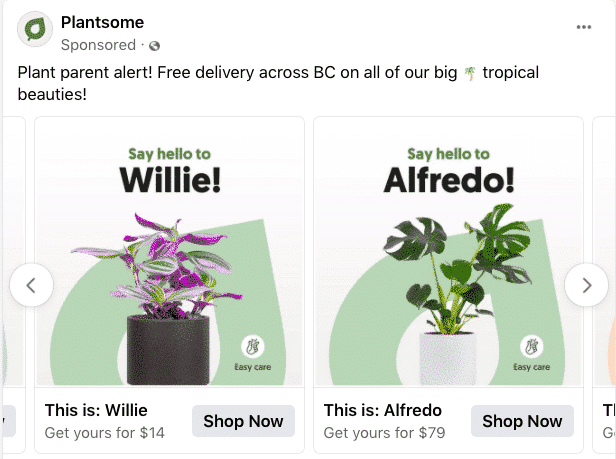
Source: Plantsome on Facebook
Slideshow ads
Slideshow ads offer an easy way to create short video ads from a collection of still photos, text, or existing video clips.
Slideshow ads have eye-catching motion, just like videos, but use five times less data. So, they load well even for people on slow internet connections. They're an easy, low-impact way to draw attention.
You can build your ad and add text and music within Ads Manager.

Source: Facebook
Collection ads
These Facebook paid ads, which are offered only for mobile devices, allow you to showcase five images or videos that customers can click to buy a product or service.
Collection ads pair with Instant Experiences (more on those below) and allow people to buy your products without ever leaving Facebook. This makes online shopping easy when people are on-the-go.
The primary photo or video can do much more than showcase a single product. For example, in this Lee Valley Tools ad, the primary video teaches viewers how to choose the right seeds for their garden. The product images below all point to supplies for planting and saving seeds.

Source: Lee Valley Tools on Facebook
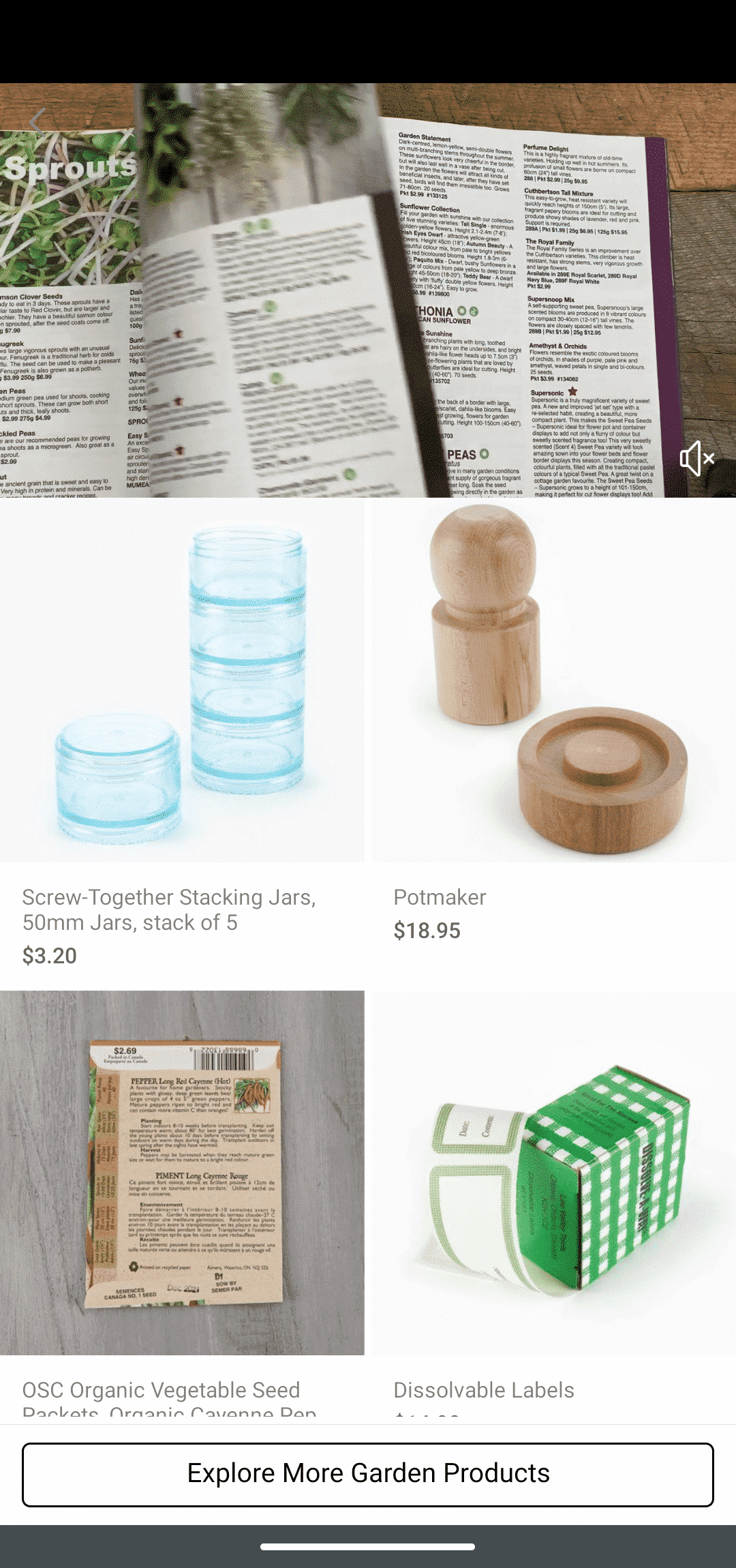
Source: Lee Valley Tools on Facebook
Instant Experience ads
Instant Experience ads used to be called Canvas. They're a full-screen ad format that loads 15 times faster than a mobile website outside of Facebook.
This ad from Kilne links to an Instant Experience with a video at the top and a carousel below.
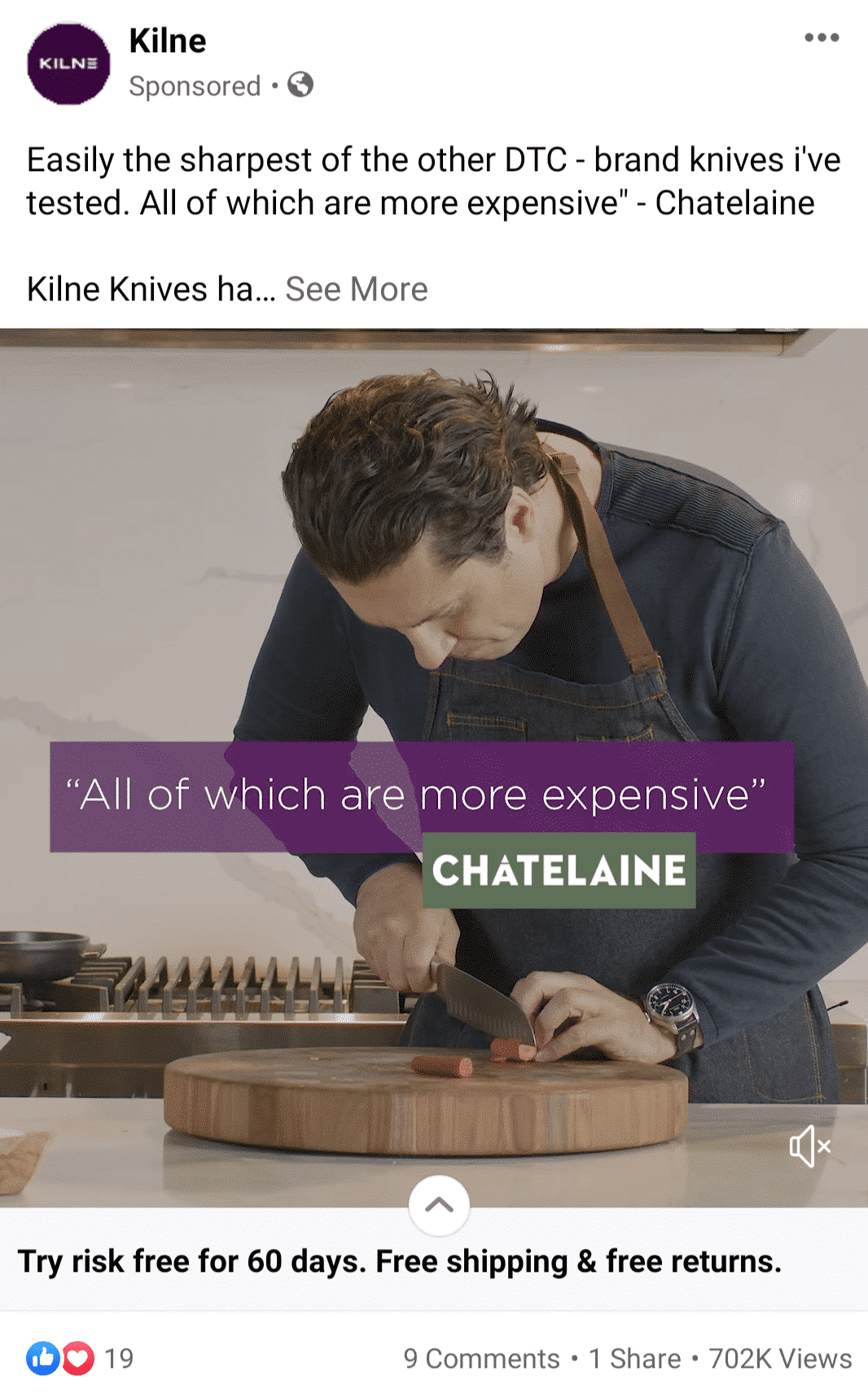
Source: Kilne on Facebook
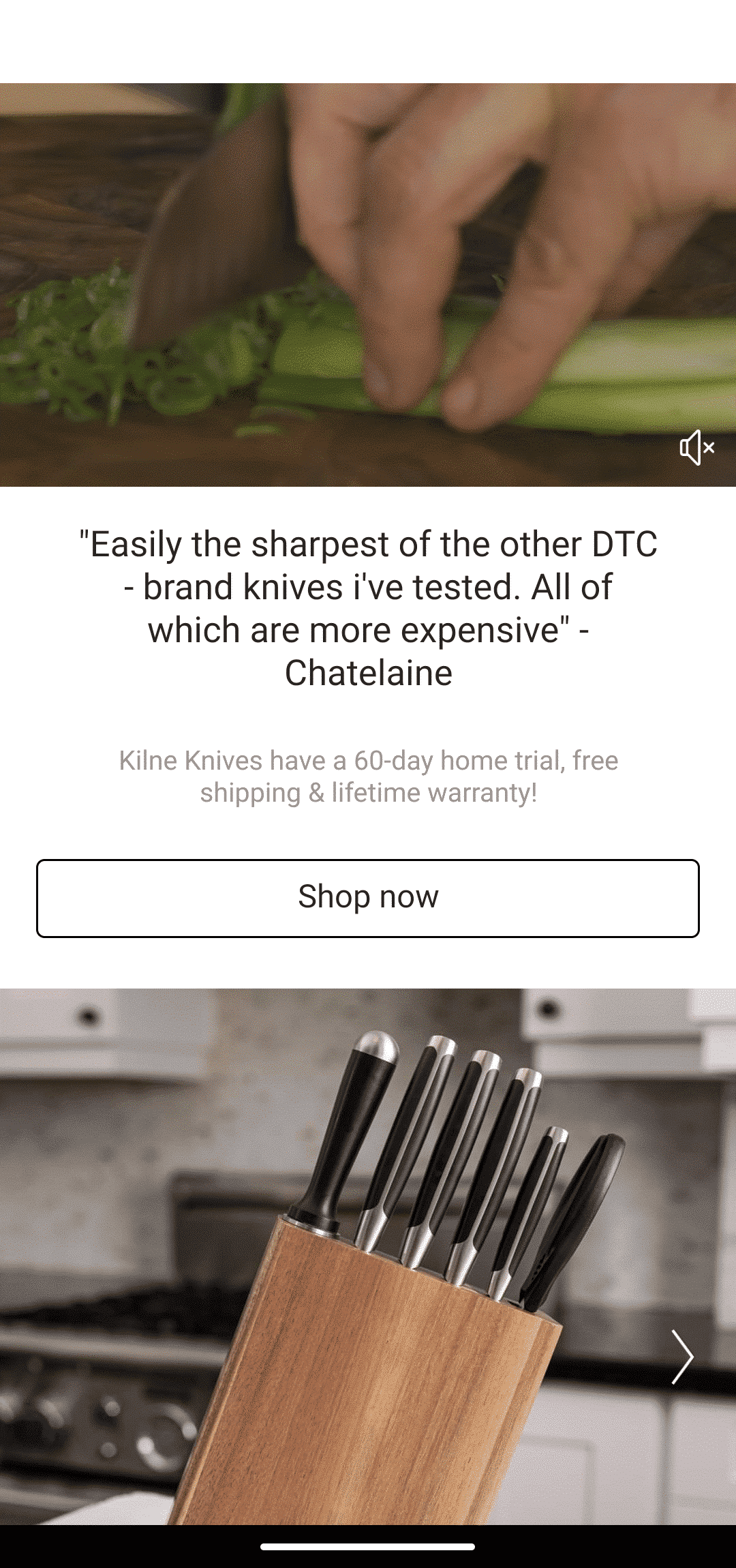
Source: Kilne on Facebook
You can also link a few Instant Experiences together so people have access to even more instant mobile content.
Lead ads
Lead ads are only available for mobile devices. That's because they're specifically designed to make it easy for people to give you their contact information without a lot of typing.
They're great for collecting newsletter subscriptions, signing someone up for a trial of your product or allowing people to ask for more information from you. Several automakers have successfully used them to encourage test drives.
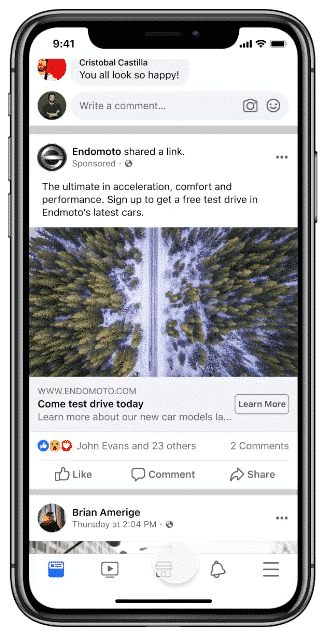
Source: Facebook
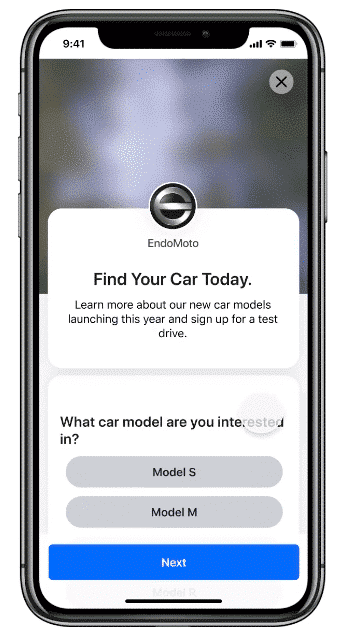
Source: Facebook
Because these ads are such a great way to feed your sales funnel, we've got a whole guide to using Facebook lead ads. It breaks down all the details you need to know to make the most of this important type of Facebook ad campaign.
Dynamic ads
Dynamic ads allow you to promote targeted products to the customers most likely to be interested in them.
For instance, say someone has visited a product page or placed a product in their shopping cart on your website, but then abandoned the purchase. With dynamic ads, you can advertise that specific product in their Facebook feed.
This reminds the potential customer to complete the purchase, and can be a very effective Facebook marketing strategy.
It's not just the product selection that can be dynamic. The Taiwanese beverage brand Nature Fruit used dynamic ads to manage the language settings for its ads when it expanded into Malaysia.
This allowed them to create a single ad that automatically ran in either English or Simplified Chinese, based on the user's preferences. The result was a 25% lower cost per add-to-cart.

Source: Facebook
You need a Facebook Business Manager account to use Dynamic ads.
Messenger ads
Facebook Messenger ads give you access to the 1.3 billion people who use Messenger every month. When creating your ad, simply choose Messenger as the desired placement. You also need to select Facebook feed.
Here's what an ad looks like in the Messenger app:
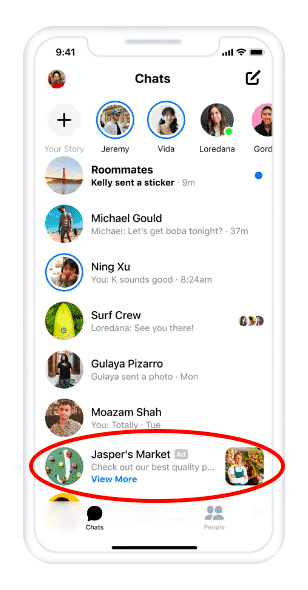
Source: Facebook
You can also run "click-to-Messenger" ads in the Facebook feed. These ads feature a call-to-action button that opens a Messenger conversation with your Facebook Page. People can use it to have a one-on-one conversation with one of your salespeople or customer service reps.
Stories ads
Mobile phones are meant to be held vertically. Stories ads are a mobile-only full-screen vertical video format that allows you to maximize screen real estate without expecting viewers to turn their screen.
Stillhouse Spirits Co. ran Facebook Stories ads as part of a campaign to reach U.S. males aged 21 to 40. They specifically targeted the ads to those interested in alcohol, cocktails, hiking and the outdoors.
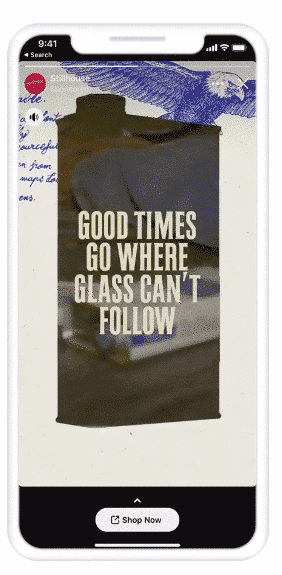
Source: Facebook
Augmented reality ads
Augmented reality ads use features like filters and animation to allow people to interact with your brand.
For example, the filter could help users see what a shade of lipstick would look like on their lips, or how a pair of glasses might fit their face.
Augmented reality ads can also be used to extend your reach. The ads allow users to take selfies with the filter and share them on their own channels.
The cosmetics band essence used mask filters in augmented reality ads to connect with their audience. The mask designs were based on an earlier round of ads that polled followers on their favorite features.
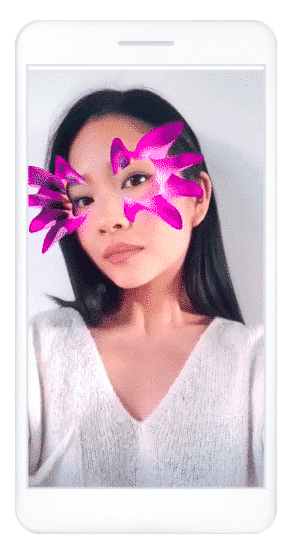
Source: Facebook
Over the course of the two-month campaign, the ads reached 6.5 million people.
Bonus: Get the Facebook advertising cheat sheet for 2022. The free resource includes key audience insights, recommended ad types, and tips for success.
Get the free cheat sheet now!
How to advertise on Facebook
If you already have a Facebook business page (and you should), you can head straight to the Facebook Ads Manager or Business Manager to create your Facebook ad campaign. If you don't yet have a business page, you'll need to create one first.
We'll follow the steps for Ads Manager in this post. If you'd prefer to use Business Manager, you can get the details in our post on how to use Facebook Business Manager.
Step 1. Choose your objective
Log into Facebook Ads Manager and select the Campaigns tab, then click Create to get started with a new Facebook ad campaign.
Facebook offers 11 marketing objectives based on what you want your ad to accomplish. Here's how they align with business goals:
- Brand awareness: Introduce your brand to a new audience.
- Reach: Expose your ad to as many people in your audience as possible.
- Traffic: Drive traffic to a specific web page, app, or Facebook Messenger conversation.
- Engagement: Reach a wide audience to increase the number of post engagements or Page follows, increase attendance at your event, or encourage people to claim a special offer.
- App installs: Get people to install your app.
- Video views: Get more people to watch your videos.
- Lead generation: Get new prospects into your sales funnel.
- Messages: Encourage people to contact your business using Facebook Messenger.
- Conversions: Get people to take a specific action on your website (like subscribe to your list or buy your product), with your app, or in Facebook Messenger.
- Catalog sales: Connect your Facebook ads to your product catalog to show people ads for the products they are most likely to want to buy.
- Store traffic: Drive nearby customers to brick-and-mortar stores.
Choose a campaign objective based on your goals for this particular ad. Keep in mind that for conversion-oriented objectives (like sales) you can pay per action, but for exposure objectives (like traffic and views) you will pay for impressions.
For this example, we'll choose the Engagements objective. From there, we need to specify which kind of engagement we want. We'll choose Page likes for now.
Some of the options you see in the next steps will vary based on which objective you choose.

Source: Facebook
Click Continue.
Step 2. Name your campaign
Name your Facebook ad campaign and declare whether your ad fits into any special categories like credit or politics.
If you want to set up an A/B split test, click Get Started in the A/B Test section to set this ad as your control. You can choose different versions to run against this ad after it's published.
Scroll down a little further to choose whether to turn on budget optimization. This option can be useful if you're using multiple ad sets, but for now, you can leave it turned off.

Source: Facebook
Click Next.
Step 3. Set your budget and schedule
At the top of this screen, you will name your ad set and choose which Page to promote.
Next, you decide how much money you want to spend on your Facebook ad campaign. You can choose a daily or lifetime budget. Then, set the start and end dates if you want to schedule your ad in the future, or choose to make it live right away.
Keep in mind that running your Facebook paid ads on a schedule may be the most efficient way to spend your budget since you can choose only to serve your ad when your target audience is most likely to be on Facebook. You can only set a schedule if you create a lifetime budget for your ad.
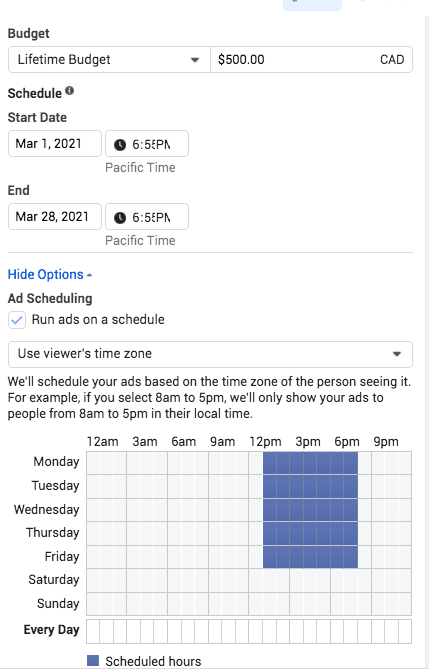
Source: Facebook
Step 4. Target your audience
Scroll down to start building the target audience for your ads.
You'll see the first option is to add a custom audience of people who have already interacted with your business on or off Facebook. We've got a separate guide to walk you through Facebook custom audiences, so here we'll focus on the targeting options.
Start by selecting your target location, age, gender and language. Note that under location, you can specifically choose to include or exclude cities over a certain size.
As you make your selections, keep an eye on the audience size indicator on the right of the screen, which gives you a sense of your potential ad reach.
You'll also see an estimated number of Page likes. These estimates will be more accurate if you have run campaigns before, since Facebook will have more data to work with. Always keep in mind that these are estimates, not guarantees.

Source: Facebook
Now it's time for the detailed targeting. Remember: Effective targeting is key to maximizing ROI—and there's no shortage of ways to target your audience using Facebook Ads Manager.
You have two fields here in which to make your audience as specific as you choose:
- Detailed Targeting: Use this field to specifically include or exclude people based on demographics, interests, and behaviors. You can get really specific here. For instance, you could choose to target people who are interested in both meditation and yoga, but exclude people who are interested in hot yoga.
- Connections: You can target or exclude people who have an existing connection to your Facebook Page, your app or an event you managed. For example, if you want to reach a new audience, you would select "Exclude people who like your Page." If you want to promote an offer or new product to existing fans, select "People who like your Page" to reach people who already know your brand. You can also choose to target friends of people who have previously interacted with your brand.
Check out these eight essential Facebook targeting tips for more on this subject.
Step 5. Choose your Facebook ad placements
Scroll down to choose where your ads will appear. If you're new to Facebook advertising, the simplest choice is to use Automatic Placements.
When you select this option, Facebook will automatically place your ads across Facebook, Instagram, Messenger and the Audience Network when they are likely to get the best results.
Once you have more experience, you may wish to place your Facebook ads in specific locations. Your options will vary based on your chosen campaign objective, but may include the following:
- Device type: Mobile, desktop, or both.
- Platform: Facebook, Instagram, Audience Network and/or Messenger
- Placements: Feeds, Stories, in-stream (for videos), search, messages, in-article, and apps and sites (external to Facebook).
- Specific mobile devices and operating systems: iOS, Android, feature phones or all devices.
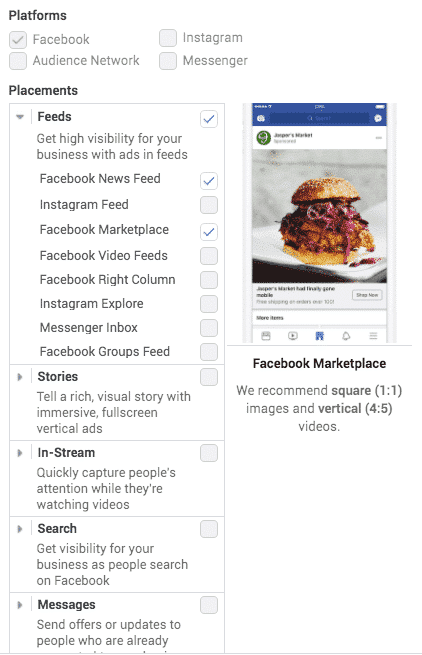
Source: Facebook
Step 6. Set brand safety and cost controls
Scroll down to the Brand Safety section to exclude any types of content that would be inappropriate to appear with your ad.
For example, you can choose to avoid sensitive content, and add specific block lists. Block lists can exclude specific websites, videos, and publishers.
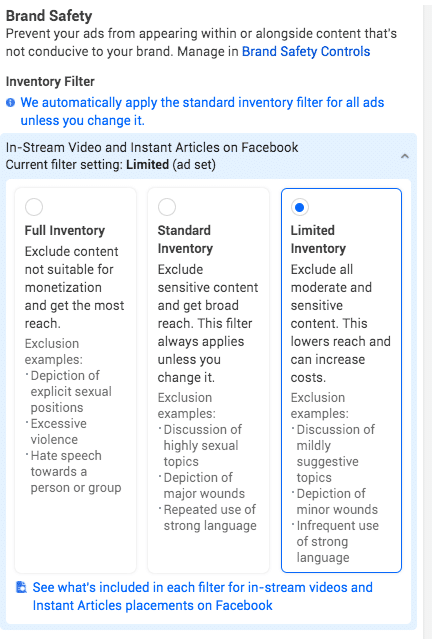
Source: Facebook
Finally, you can optimize your ad bidding strategy and bidding type, and add an optional bid control. If you're new to Facebook advertising, you can start with the default options.
If you have more experience, tailor the options here to best match your budget strategy with your campaign goals.
When you're happy with all your options, take a last look at the potential reach and conversion estimates. If you're happy with what you see, click Next.
Step 7. Create your ad
First choose your ad format, then enter the text and media components for your ad. The formats available will vary based on the campaign objective you selected back at the beginning of this process.
You can get quite creative here. If you're working with an image, try clicking Turn into Video to create a short animation. Or, click Create Slideshow to build a Slideshow ad with the built-in Video Creation Kit.
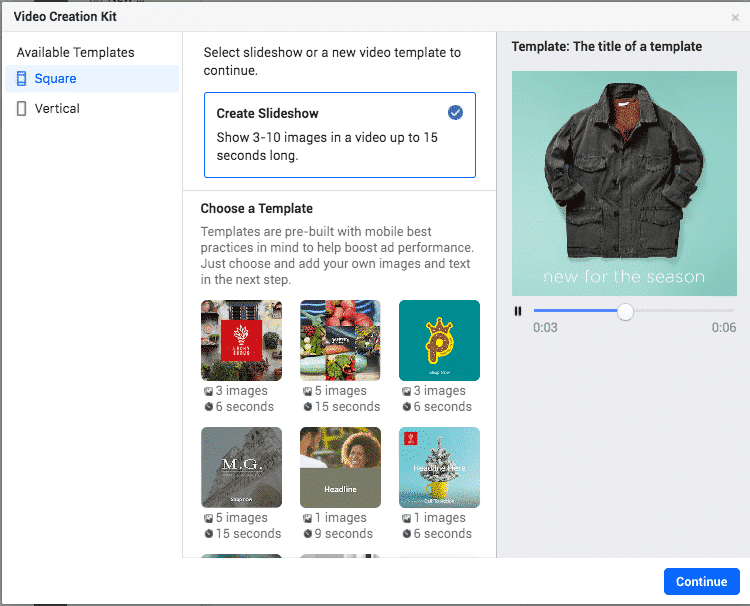
Source: Facebook
Use the preview tool at the right of the page to make sure your ad looks good for all potential placements. When you're happy with your choices, click the green Publish button to launch your ad.
Facebook ad specs
There are a lot of details to keep in mind when getting your images and videos ready for Facebook ads. Since these details can change often, we've compiled them in a separate, regularly updated post on Facebook ad sizes.
We've also got a set of 16 free Facebook ad templates you can use to create your ads in just a few minutes.
Text and objective specs for Facebook ads
To create the best Facebook ads, you need to keep the recommended character counts in mind. Anything beyond these text limits will be cut off.
You also need to understand which types of Facebook ads work with each of the ad campaign objectives described above.
Image ads
- Headline: 40 characters
- Link description: 30 characters
- Body text: 125 characters
- Campaign objectives: All except video views
Video ads
- Headline: 40 characters
- Link description: 30 characters
- Body text: 125 characters
- Campaign objectives: All except catalog sales
Facebook Stories ads
- Text: No set character count. Aim to leave 250 pixels text-free at the top and bottom of the ad.
- Campaign objectives: All except engagement and store visits
Carousel ads
- Headline: 40 characters
- Link description: 20 characters
- Body text: 125 characters
- Campaign objectives: All except engagement and video views
Slideshow ads
- Headline: 25 characters
- Link description: 30 characters
- Body text: 125 characters
- Campaign objectives: All
Collection ads
- Headline: 40 characters
- Link description: n/a
- Body text: 125 characters
- Campaign objectives: Traffic, conversions, catalog sales, store traffic
Instant Experience ads
- Text: Blocks of text up to 500 words each
- Button text: 30 characters
- Campaign objectives: All except lead generation
Messenger Inbox ads
- Headline: 40 characters
- Link description: n/a
- Body text: 125 characters
- Campaign objectives: Traffic, app installs, conversions, catalog sales, messages
Facebook ads cost
How much does it cost to advertise on Facebook? The answer is, it depends.
In-depth research by AdEspresso shows the main factors that affect Facebook ads cost are:
- Timing: The month, day and even hour can affect ad cost.
- Bidding strategy: Whether you choose the lowest cost or a specific bid cap.
- Ad placement: Higher-competition spots cost more.
- Ad relevance: Low scores for your ad's engagement ranking, quality ranking or conversion ranking can raise costs.
- Target audience: Higher competition audiences cost more.
Keeping all of this in mind, AdEspresso calculated the average cost per click for Facebook ads in Q3 2020. Broken down by campaign objective, the average costs were:
- Impressions: $0.98
- Reach: $1.03
- Lead generation: $0.67
- Conversions: $0.25
- Link clicks: $0.16

Source: AdEspresso
Cost per like was a bit of a roller coaster in 2020. As of September, the average was down to $0.15.
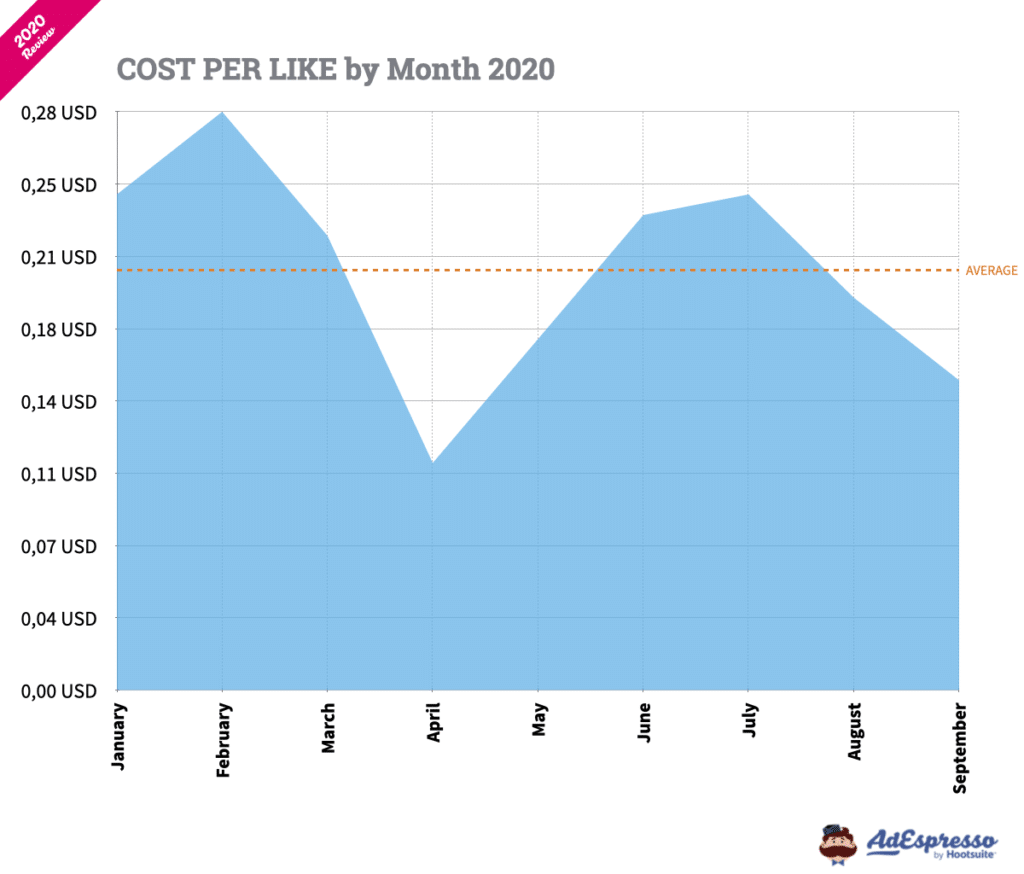
Source: AdEspresso
5 smart tips for running Facebook ads
1. Don't neglect higher funnel marketing
It can be easy to focus on short-term conversions when calculating the value of a Facebook ad campaign. But research from Facebook, Analytic Partners and GroupM shows that higher funnel brand-building ads can drive sales at a similar rate per dollar spent.
In fact, in health care, brand messaging drove more sales than direct response campaigns for those aged 35 to 54. However, direct response drove more sales for teenagers.
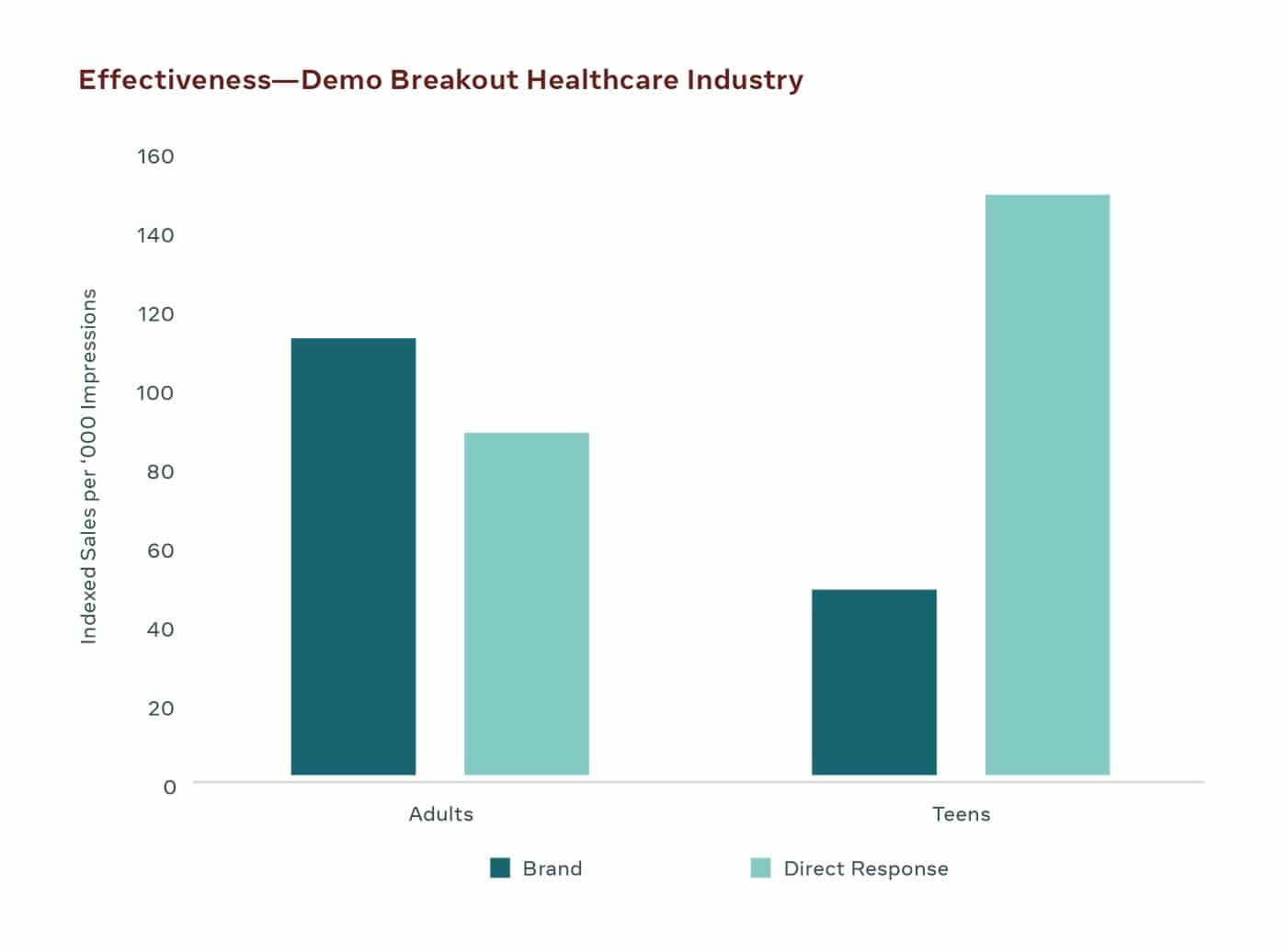
Source: GroupM via Facebook
There's no one answer about what ad objectives make the most sense for your Facebook ad campaign. That's why you need to set specific goals early on.
2. Use the Facebook Pixel—and get ready for changes
The Facebook pixel is a small piece of code that can have a big impact on your Facebook ad campaigns. Once you place the code on your website, it allows you to track conversions, remarket to people who have viewed a product on your site and create lookalike audiences.
Even if you're not ready yet to engage in some of the more advanced Facebook pixel strategies, you should install it now. That way you'll have tracking and remarketing data ready to go when you are ready to start optimizing your Facebook ads.
That said, changes are coming. Apple's upcoming iOS 14 changes will impact how the Facebook pixel functions. There are a few steps you can take to get ready, like verifying your domain in Facebook Business Manager.
If you work with a developer, you might also want to consider using the Conversions API for more accurate tracking of conversions data not affected by cookies.
For more details on the changes, check out Facebook's guide to the pixel updates.
3. Experiment with ad frequency
Remember back in the days when everyone watched TV and we could all recite our favorite breakfast cereal jingles? How many times do you think kids watching Saturday morning cartoons were exposed to the same ads for Magic Charms?
It's rare for a new prospect to take action the first time they see an ad for a product they've never heard of, or to remember a brand name after hearing it just once.
Facebook IQ research shows that while there is no optimal number of exposures for every ad (yes, again, you'll have to test), more exposures do seem to lead to higher purchase intent. But, of course, there's a limit. At a certain point, the benefit of more exposures to the same ad—or related ads— starts to slow down.
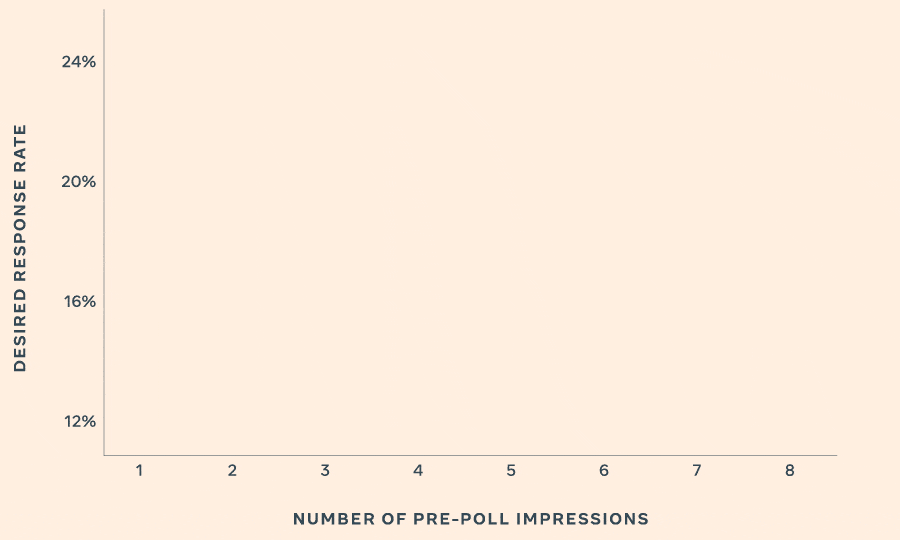
Source: Facebook IQ
Your testing will show you where the plateau is for you. Keep in mind that better quality ads plateau later. That's not really surprising, right?
Speaking of testing…
4. Test everything
It's important not to make assumptions about what will work and what won't in your Facebook ads. Every time you try something new, you should test it against your previous ads so you can see whether you're making improvements to the metrics that matter most to you.
The best practices for Facebook ads are constantly changing. Only you know what works for your specific audience. And the only way you can keep that knowledge up to date is by testing.
Since this is such an important topic, we've got a whole guide on how to use social media for A/B testing.
5. Track and optimize performance
Closely monitor how your campaigns perform in the Facebook Ads Manager dashboard. If a campaign isn't performing well, put your money into an ad that is instead.
If you're just starting out, it might make sense to run several ads with small audiences and budgets. Once you've determined what works best, use the winning ad as your primary campaign.
Over time, you'll learn how to improve your Facebook ad conversions. A Facebook meta-analysis shows that ads developed through testing and refining had a 26% lower cost per action.
There are tools to help simplify—and even automate—this process.
Hootsuite Social Advertising is an integrated platform for managing organic and paid content side by side. Within the dashboard, you can easily pull actionable analytics and build custom reports to prove the ROI of all your social campaigns.
With a unified overview of all social media activity, you can easily make data-informed adjustments to live campaigns (and get the most out of your budget). For example, if an ad is doing well on Facebook, you can adjust ad spend across other platforms to support it. On the same note, if a campaign is flopping, you can pause it and redistribute the budget — all without leaving your Hootsuite dashboard.
Facebook ad ideas
Ready to go but not sure what you should promote with your Facebook ads?
We've put together three campaign strategies to get you started. If you're looking for more inspiration, check out our roundup of great Facebook ad examples.
Facebook advertising strategy 1: Convert a proven piece of content into a video or image ad
Every brand has a few pieces of content that drive most of the traffic each month. Adapting that content into a short video or image ad can be a great way to repackage top content for the best Facebook ads.
To create a video, think about ways to convey your content's key messages through short text and images. Then, use one of these social video tools to create your video, or create a slideshow video ad in Facebook Ads Manager.
To create an image ad, try making an infographic from your content's key points. For example, the Hootsuite social team pulled the key details from our post on social media image sizes into this image for Facebook:
Pro tip: Check out our social video strategy kit for marketers, which has lots of great insights about what types of video work best on social media.
Facebook advertising strategy 2: Drive a direct sale
Yes, we said above you should consider using Facebook ads for higher funnel marketing. But if you're looking to make direct sales, there are plenty of ways to do so.
Pro tip: One of the most effective ways to drive sales directly from a Facebook ad is to target people who have already considered buying your product.
You could try targeted offers, product recommendations or reminders to complete a purchase.
The fashion retailer Axel Arigato used video ads, including ads in Facebook Stories, to reach a 98% increase in purchase conversions. By expanding their targeted audience, they also saw 2.3 times more first-time sales.
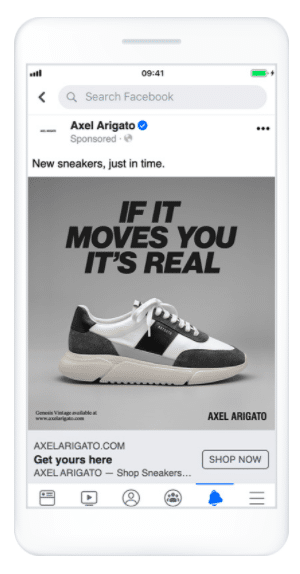
Source: Facebook
The conversions and catalog sales objectives both drive direct sales. Conversions drives sales on your website or any other location outside of Facebook.
Catalog sales drives sales from your Facebook catalog. You can use dynamic ads to connect people directly with products they're likely to want in your Facebook shop.
Facebook advertising strategy 3: Think beyond the web
You don't have to limit your Facebook advertising strategy to online sales. With the store traffic objective, you can promote offline purchases, too.
You can also drive people to an online or offline event. Use the engagement objective to increase event responses on Facebook, or the traffic or conversions objectives to sell more tickets.
Or, use the lead generation objective to get people to your store or dealership to experience your product in person—for example, through a test drive.
Johnny Walker Taiwan used ads with a click-to-Messenger call to action to drive offline sales. Within the Messenger conversation, users could select their favorite products and ask for directions to nearby shops where they would purchase.
Pro tip: Facebook allows you to track offline conversions so you can understand the effectiveness of ads that drive sales offline. You can also use this tracking information to build custom audiences of people who interact with your brand offline, so you can target them even more effectively with future ads.
Use Hootsuite Social Advertising to easily keep track of all of your social media activity — including Facebook, Instagram and LinkedIn ad campaigns — and get a complete view of your social ROI. Try it free today.
Request a Demo
Easily plan, manage and analyze organic and paid campaigns from one place with Hootsuite Social Advertising. See it in action.
Free Demo
Source: https://blog.hootsuite.com/how-to-advertise-on-facebook/
0 Response to "How to Create a Facebook Retargeting Campaign Easy Guide Cpc Strategy"
Post a Comment